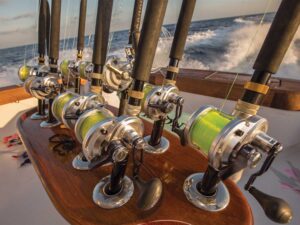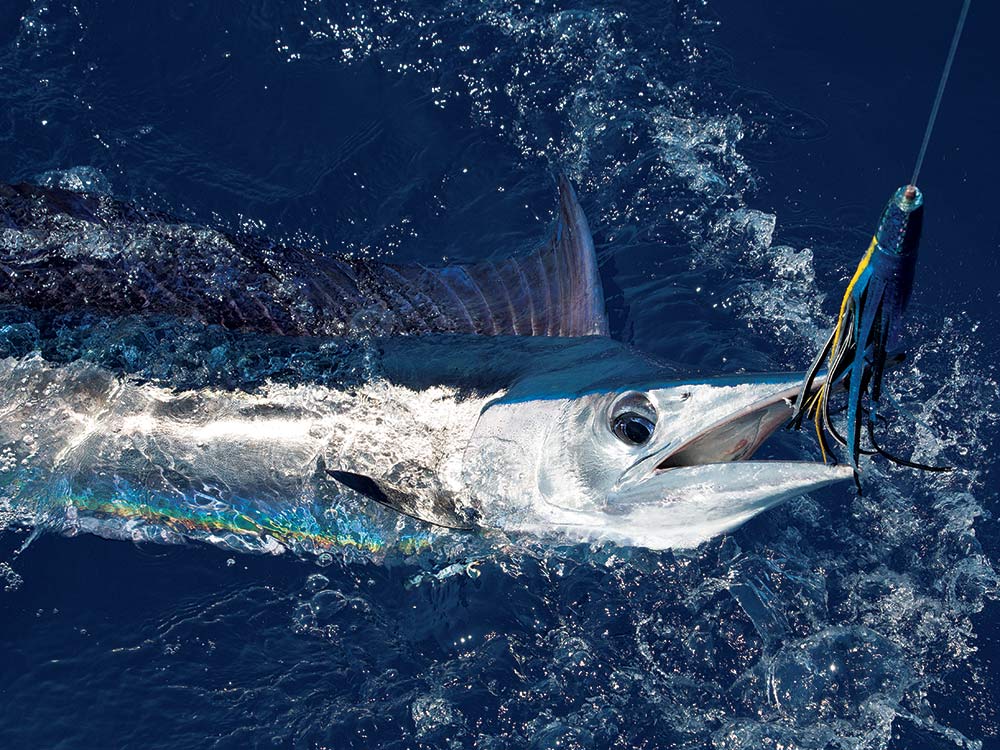
Editor’s Note: Sadly, this is Jim Rizzuto’s final article in Marlin. After a long and storied career, including hundreds of articles and numerous books on fishing in Hawaii, Rizzuto lost a valiant battle with pancreatic cancer in July, 2017. The world is a lesser place. Mahalo for the memories, Jim, from all your past and present friends at Marlin. –Ed.
The tiny bill of a shortbill spearfish looks more like a joke than a javelin. But don’t be fooled: Spearfish — known locally as chuckers — live in a dangerous neighborhood and must fight to avoid being eaten by their hungry relatives. And despite appearances, the spear of a 30-pound spearfish can do a lot of damage, as a 707-pound blue marlin discovered one sunny April morning in Kona, Hawaii.
Angler Mike Hartman caught the big blue aboard Vixen with Capt. Kevin Hibbard and crew Pat Crackel during a jackpot tournament, and they got the leader after an hour-and-a-half fight. With the fish in sight, Crackel and Hibbard instantly saw the red and white scar of a fresh injury on the marlin’s forehead. After Hibbard weighed the fish at the dock to claim their winnings, he inspected the scar more closely and found a protruding piece of bone. He pulled on the bone and retrieved an 8-inch-long spear — the entire bill and upper jaw of a shortbill spearfish.
What happened to the rest of the spearfish? They found the answer in the distended belly of the big blue. The spearfish lost the battle, and the marlin celebrated its victory by wolfing it down. The take-away from this tale: Big marlin eat spearfish, but spearfish don’t make it easy for them. And they also don’t make it easy for any fisherman who wants to use a spearfish to catch a big blue.
An Artificial Chucker
Attacks by big blue marlin on small spearfish happen often in Hawaiian waters, and anglers are trying to solve the puzzle of how they can use spearfish to catch giant blues. In recent years, captains Hibbard, Bryan Toney and Jason Holtz, and their fishing friends, have been experimenting with lures and teasers designed to look like spearfish in hopes of raising the biggest blues in the Central Pacific. Their most promising attempt so far is an interesting creation known as the Rubber Chucker, and it has attracted very big blues in some spectacular ways.
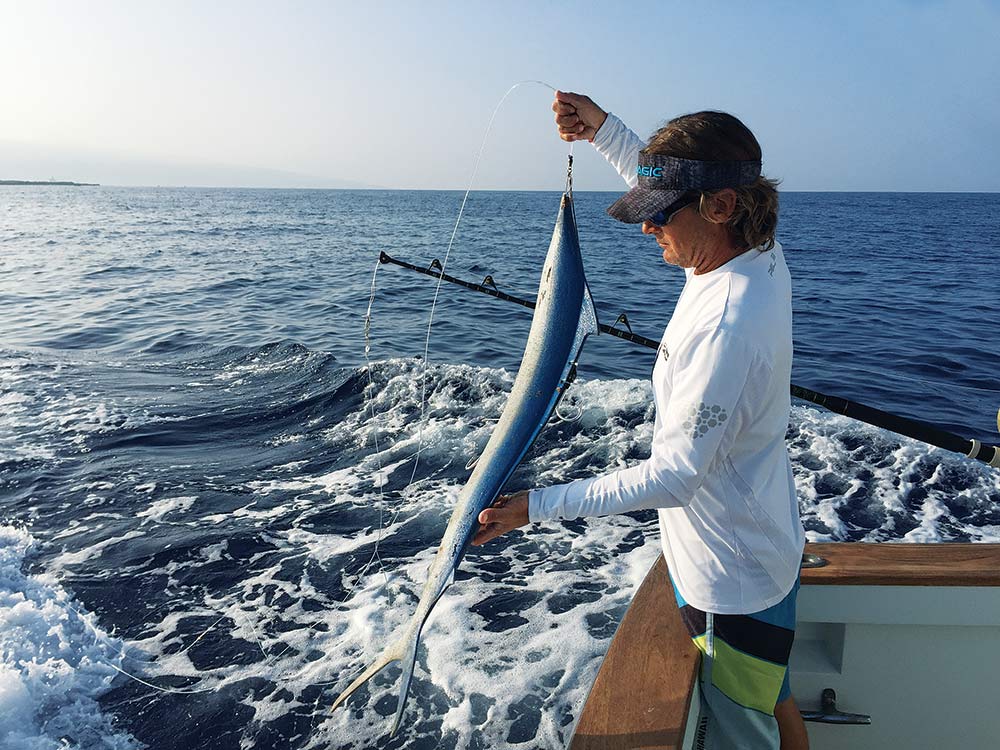
The Rubber Chucker is constructed of a dense, flexible foam body molded on top of a composite core that is made out of a combination of high-density fiberglass and woven, unidirectional carbon tapes to give it the appearance and dimensions of a 16- to 18-pound shortbill. With its 42-inch length, “we are always swinging for the fences,” Hibbard explains. On one occasion, Toney and Hibbard were towing it on the third wave where it rode the surface “like a boogie board,” says Hibbard. “And a monster head came out of the water behind it and left a massive hole in the water where the spearfish had been. The fish switched from the spearfish to a lure nearby and got hooked.” They eventually released the marlin, after calling it “9-plus-plus.”
Knowing how a marlin juggles a spearfish is important just to answer the fundamental question: Where should you put your hook? “Five years ago, the biggest marlin I ever saw came up and grabbed a spearfish,” Toney says. “I was sitting there watching a chucker pick at a lure on the long rigger, and a few seconds went by before a gigantic blue marlin showed up about 30 feet behind the spearfish. Then the marlin powered ahead and swallowed the chucker.”
After seeing this strike, Toney began to experiment with rigging the hook at the tail end of the Rubber Chucker. “I ran it about 15 times that spring with the hook hanging out past the tail,” he says. “We got two bites on it from big fish, but we didn’t hook either one. One of the fish was the 900-pounder with Hibbard, which switched over and ate a lure. The other was a 600- or 700-pounder that completely mauled the Rubber Chucker without getting hooked.”
A Possible Answer
Capt. Chris Donato may have seen the answer to the question in action when he and his mate, Mike Dakil, saw a spearfish free-jumping off to one side of Benchmark, his classic 37-foot Merritt. The spearfish was jumping from side to side as though it were evading something below, and both Donato and Dakil knew the fish was being chased even before they saw a huge head and bill erupt from the water and attack the shortbill. After both fish disappeared, Donato spun the boat around and ran to the spot to try for the marlin.
Dakil climbed to the tower as Donato watched from the bridge, and they were amazed when they caught up with the marlin and saw that it was swimming about 20 feet below the surface with the spearfish in its mouth like a dog with a bone. The big marlin had grabbed its quarry by the middle and was shaking it as though it were trying to break its back before attempting to swallow it.
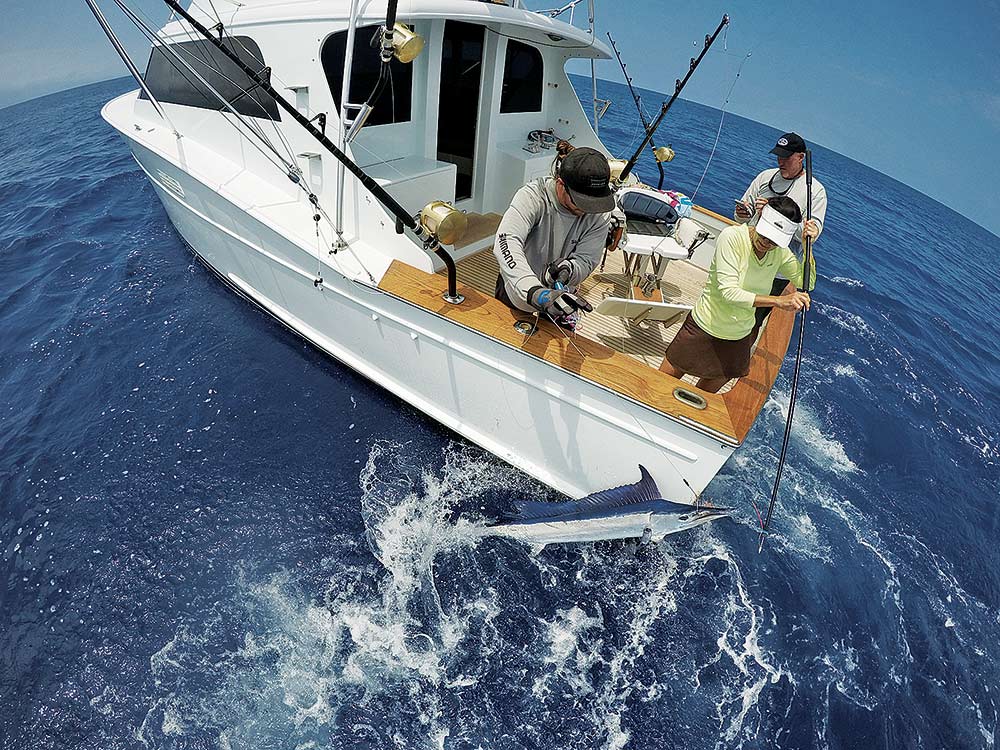
With experiences like Donato’s in mind, Toney says the long Rubber Chucker has an inherent problem with how to rig it so that it would hook a marlin that T-bones it, and “if the marlin grabs the spearfish by the middle to break its back, then they probably fold the fish over and swallow it bent back on itself,” Toney explains.
The fold-over feeding mechanism also helps the blue keep the shortbill’s nasty little dagger away from its eyes. “We’ve seen more marlin than just the 707-pounder with spearfish bills in their heads,” Toney says. The fold-and-swallow is what other predator fish are known to do with the long, skinny fish they prey upon. When, for example, you find a needlefish in the belly of a mahimahi, it’s usually folded over with the bend at the rear of the gut and the head and tail forward near the gills.
Improved Rigging
So Toney is now experimenting with a new rigging strategy that places a pair of hooks near the middle of his bait with one hook on each side. The trick is to make the rig conform to IGFA rules, which Toney says can be done as long as one hook is placed farther back than the other.
Though the Rubber Chucker is huge, Toney thinks a pair of 12/0 hooks might be large enough for big blues, without having to resort to 14/0 or 16/0 hooks. “If the fish comes up and opens its mouth to bite it, the fish is likely to get hooked. Rather than a lure, the chucker imitation looks more like something they would normally eat instead of something with just a shape in a bubble trail,” says Toney.
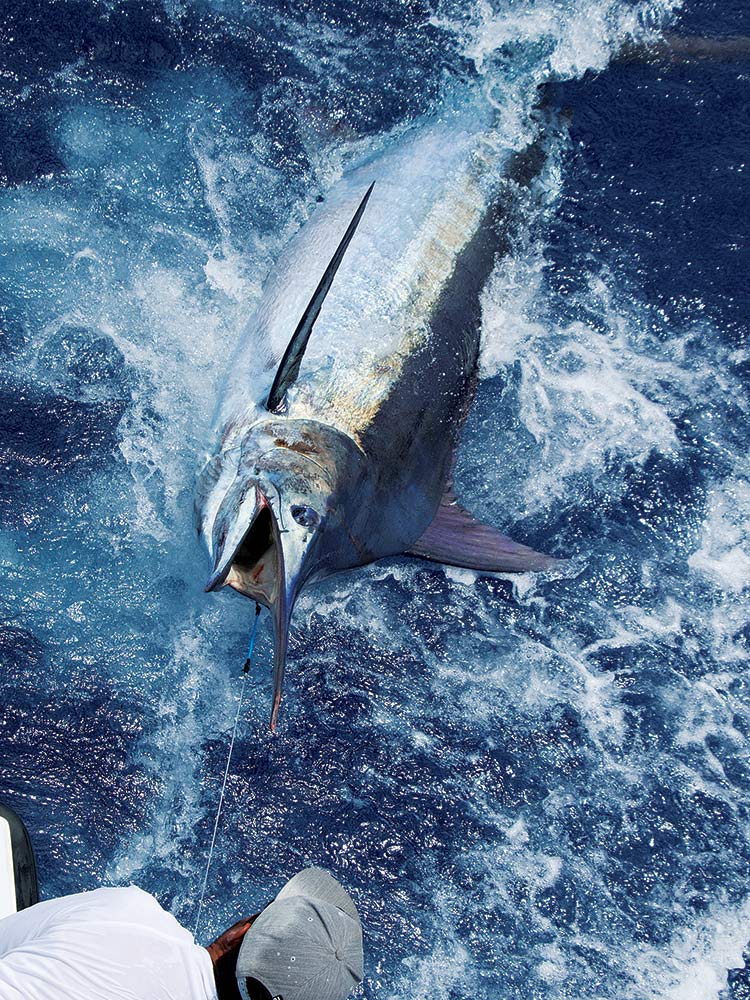
So why not forget about hooks and use the Chucker solely as a teaser and just switch a curious fish over to trolling lures nearby? “I would always want to keep a hook in the Chucker because of what I am after: a giant marlin,” Toney says. And as he described his mission, he was obviously thinking of the 1,305-pound Atlantic blue he steered angler Jada Holt to last year off Ascension Island. “I’ve heard too many stories about big marlin that tore off teasers and then disappeared,” he says.
The Chucker Test
The ultimate question for the Rubber Chucker might be: Is it sexy enough to fool a grander? The penultimate question was already answered on a day in mid-March, when packs of spearfish prowl the coast of Kona. Hibbard was aboard Piper with his fishing friend Capt. Jeff Kahl when they set out his Rubber Chucker as a teaser in a standard Kona spread of four billfish and tuna lures that were attached to tag lines to lift the leaders off the water and give the lures the most enticing action possible.
Hibbard and Kahl were chatting when the tag-line releases began to snap, and all four lines came down from the riggers.
Just like that, they were hooked to four curious chuckers that could not resist checking out what their sexy rubber cousin was up to. The Rubber Chucker proved to be an imitation sincere enough to attract a mate that’s also a great-looking bait.
Baiting with a Spearfish
So why not bait with a real spearfish? Some have tried, and few, if any, have succeeded. Toney says he has tried to live-bait with a spearfish a few times without success. “They never last more than an hour before you end up skipping them,” Toney says. “I’ve never had a bite on a dead one either. But I haven’t really tried it enough to say whether it does or doesn’t work. “I think we would get bit if we did put time into it, but the odds of a hookup are against you,” Toney continues. “When you live-bait with a head-rigged tuna, you count on the marlin to turn it and swallow it headfirst.” But that’s not the way a marlin eats a spearfish to begin with, and the fish’s long shape greatly increases the chance of the hook turning back into the bait instead of anchoring in a good spot in the marlin’s mouth.
A Near Grander
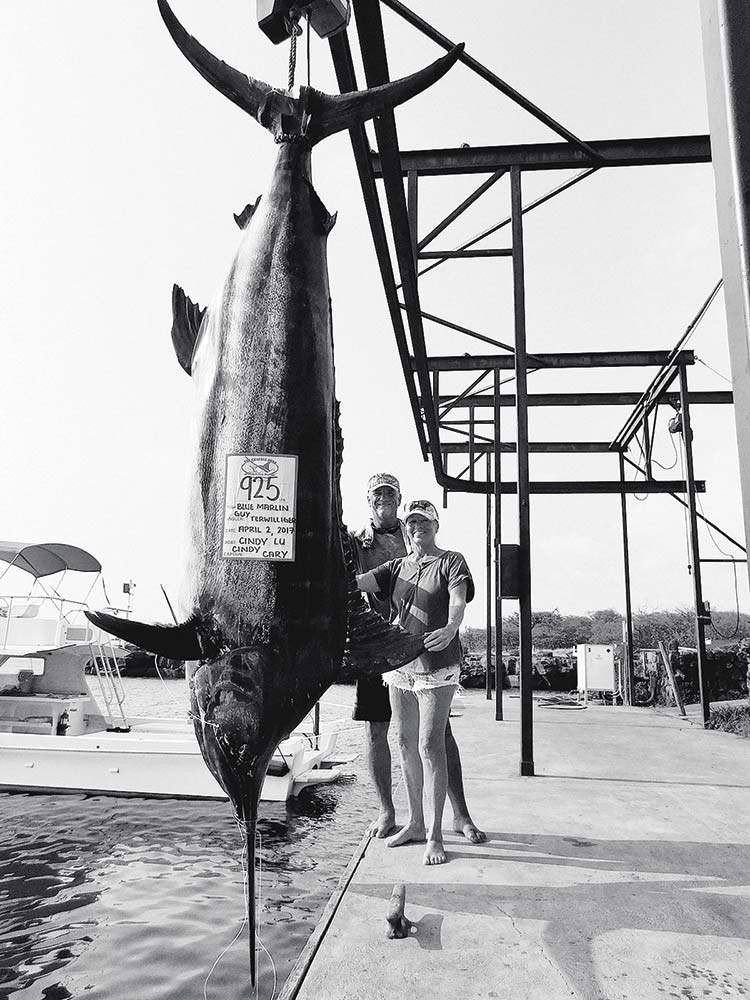
Capt. Guy Terwilliger and Cindy Cary boated this 925-pound blue aboard Cary’s 23-foot skiff, Cindy Lou, on April 2, 2017, and it’s the largest marlin weighed in Kona in over a year. The fish ate a live bait, and Terwilliger fought the fish for over two hours. The catch is proof of giant blue marlin still roaming off the Kona coast. Now, a big one just needs to eat the Rubber Chucker.
Does Color Matter?
Shortbill spearfish are strikingly colorful, with a cobalt blue back and flashy chrome sides. The obliterative coloration partially hides the fish from predators because the blue and silver don’t stand out against the background. The Rubber Chucker, on the other hand, is almost black because it’s made from dark materials.
“All black might just be what a marlin sees in silhouette when it spots a baitfish on the surface,” Hibbard says. “Just having a bigger object on the surface might very well bring up more — and bigger — fish regardless of color.” But when in doubt, always fall back on the first rule of imitations: Match the hatch.
Toney uses spray paint to give his Rubber Chuckers a blue back with silver sides, but that’s not a permanent fix. “The spray paint looks good for a few days and then starts coming off,” Toney says. “After they get a few bill marks, you need to fix them up or leave the scars to show that the teaser gets action.” And as Toney continues to fine-tune the Rubber Chucker, his search continues for natural-looking paints that are more durable and adhere better to the Rubber Chucker.
Science Talk
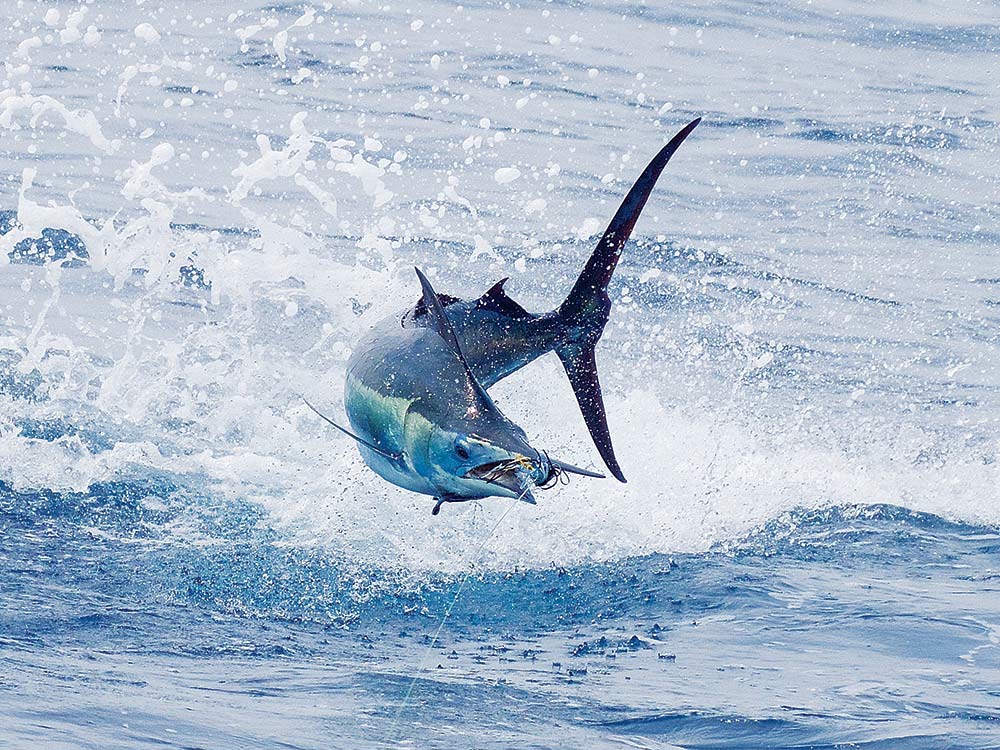
It’s a fact known for more than half a century: Small billfish of many kinds are definitely on the blue marlin menu in Hawaii. During the Hawaiian International Billfish Tournament in the 1960s and ’70s, it was common to bring all catches to the dock so a team of scientists could examine the stomach contents. In addition to finding examples of everything that swims, from blowfish to bonito, the researchers also found billfish bones and remnants of bills — even bodies. At an HIBT in the early 1970s, scientists examined a marlin caught by Hawaiian singer Danny Kaleikini and found an intact broadbill swordfish. The marlin had swallowed the fish whole, including its impressive weaponry; the sword of a young swordfish is nearly as long as its body. In this case, however, it seemed to be no more than a convenient way for the marlin to keep its prey pointed nicely down its gullet.
The scientists found the bills of three small cousins, perhaps even heirs, inside another marlin’s belly.
And when the HIBT scientific team showed me the partially digested bills, they told me that they appeared to be from small striped marlin or big spearfish. We know that blues are opportunistic feeders, but this one fish in particular was grabbing smaller cousins at every opportunity!
Billfish are especially well-adapted to eat spiny, thorny, finny, bony creatures full of hard, sharp points. Their stomach acid is strong enough to burn your skin if you splatter yourself with it. And if they can’t dissolve something, they can eject it by turning their stomachs inside out and disgorging the contents.
Unique to Hawaii?
Donato has fished Benchmark throughout the South Pacific, but he didn’t encounter the spearfish and blue marlin connection until he moved his charter business to Hawaii. “In Vanuatu, we got a run of spearfish bigger on average than the ones here in Hawaii, but we never saw a marlin go for a spearfish,” Donato says. “And I never heard captains, or anyone else, talking about it.”
Toney regularly fishes Ascension Island in the Atlantic Ocean and says he would bet money that Ascension’s grander marlin eat longbill spearfish there. “They’ve found sailfish in marlin bellies caught off Ascension,” Toney says. “For a big marlin, anything smaller is food.”
So when Toney returns to Ascension in the Atlantic for another try at grander-size blues, he says he is definitely bringing his Rubber Chucker. To Toney, it doesn’t matter if the fish think it’s a longbill spearfish, sailfish or white marlin — it has the look like something big blues like and ultimately eat. Time will tell whether the Rubber Chucker accomplishes its mission.
